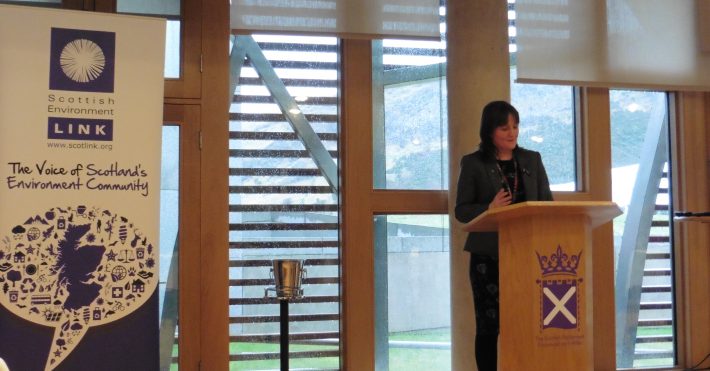SPG Scottish Environment Week Breakfast
Tagging MSPs, urban meadows and eDNA data: the Science for Environmental Futures breakfast event

The Science for Environmental Futures breakfast event (jointly organised by British Ecological Society Scottish Policy Group, RSPB, Butterfly Conservation and Royal Zoological Society of Scotland, with support from Buglife and the Hebridean Whale and Dolphin Trust) took place on 23 February as part of Scottish Environment Link’s Scottish Environment Week 2017. Maree Todd, MSP for the Highlands and Islands, opened the event by describing her experience of being tagged using the same technology that the RSPB has been using for seabird tracking and conservation. This kind of innovative satellite tagging enables RSPB to tackle threats to seabirds more effectively, as well as demonstrating how far afield Scottish MSPs can venture over the course of a week! The four talks given at the event showcased a range of ecological research and new technologies which are helping to increase understanding and provide solutions to the environmental challenges that Scotland faces. Placing science at the heart of policy responses enables Scotland to be in a strong position to manage its natural environment for current and future generations.
Seabird tracking through the use of satellite tags can be a conservation game-changer
Alex Kinninmonth from RSPB delivered a fascinating talk, arguing that seabird tracking through the use of satellite tags can be a conservation game-changer. By enabling scientists to understand more about where species feed, the types of habitat they use and the places they visit, this technology helps guide conservation efforts and the provision of suitable habitats. In the case of Maree Todd, the satellite tags showed a notable fondness for visiting sushi restaurants and distilleries! David Attenborough described Scotland’s seabirds as one of the twelve wildlife wonders of the world; satellite tagging offers the chance for greater understanding of these species’ habits to guide more effective conservation of this wonder.
Providing good-quality, well-connected habitats within towns and cities is of the utmost importance
Anthony McCluskey from Butterfly Conservation Scotland highlighted the role of new approaches to the built environment in habitat creation, focusing on how butterflies use urban meadows and green roofs. Butterfly populations are declining faster in urban areas than rural, so providing good-quality, well-connected habitats within towns and cities is of the utmost importance. Existing green roofs, while environmentally beneficial, are often comprised of one type of grass and little other vegetation. By planting patches of wildflowers which caterpillars of butterflies and moths can feed on in existing developments and incorporating them into future designs, butterflies can be provided with warmth, food and shelter and attracted back into urban areas.
The natural environment forms a crucial part of Scotland’s identity, inspires art and culture, supports the economy and delivers enormous health and wellbeing benefits
Gill Murray-Dickson from Royal Zoological Society of Scotland discussed the growing use of environmental DNA (eDNA) in conservation and biodiversity monitoring. eDNA is the sample extracted from materials such as soil, water or air where species have left a genetic trace of their presence. This can be used to determine species presence in different habitats where direct observation is more difficult. In addition to taking DNA from the environment (‘the good’), Murray-Dickson discussed the use of faecal DNA (‘the bad’) and DNA taken from insects and invertebrates (‘the ugly’). This innovative trio of genetic tools enables more accurate and effective biodiversity monitoring in order to inform conservation management.
Finally, Robin Pakeman of the James Hutton Institute, and a member of British Ecological Society’s Scottish Policy Group, discussed how to target agri-environment spending in the most effective manner, a crucial topic in the context of Brexit. A number of debates exist about the best way to target this spending, and whether the focus should be solely on preserving biodiversity or delivering multiple environmental benefits, as well as whether more emphasis should be placed upon current or future distributions of species. The current Scottish Rural Development Plan was the first Scottish agri-environment scheme to target resources to benefit the most species by funding individual management options. Current research is focused on developing this targeted approach to ensure good coverage across all species of concern and to prioritise individual declining species.
By placing rigorous research and innovative technology at the heart of the response to environmental challenges, Scotland can ensure a safe and sustainable future
While the speakers addressed a range of ecological challenges, the place of innovative research and technologies in guiding conservation policy was a unifying theme. The natural environment forms a crucial part of Scotland’s identity, inspires art and culture, supports the economy and delivers enormous health and wellbeing benefits. Over the coming decades, the Scottish environment will face a range of challenges, from climate change to invasive species, pollution to fisheries management. By placing rigorous research and innovative technology at the heart of the response to these challenges, Scotland can ensure a safe and sustainable future for its natural environment.
Like what we stand for?
Support our mission and help develop the next generation of ecologists by donating to the British Ecological Society.